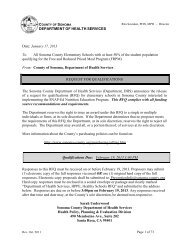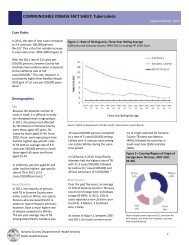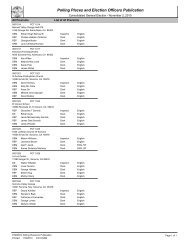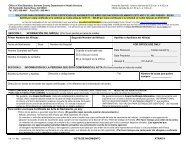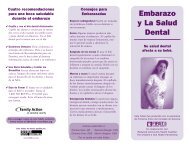Ticks & Lyme Disease: California's Perspective - County of Sonoma
Ticks & Lyme Disease: California's Perspective - County of Sonoma
Ticks & Lyme Disease: California's Perspective - County of Sonoma
You also want an ePaper? Increase the reach of your titles
YUMPU automatically turns print PDFs into web optimized ePapers that Google loves.
<strong>Ticks</strong> & <strong>Lyme</strong> <strong>Disease</strong>:<br />
California’s <strong>Perspective</strong><br />
April 2004<br />
Gary Green, MD<br />
Infectious <strong>Disease</strong>s<br />
Kaiser Medical Center<br />
Santa Rosa, California
Credible <strong>Lyme</strong> Pamphlets<br />
www. dhs.ca.gov/ps/dcdc/disb/disbindex.htm www.aldf.com
<strong>Ticks</strong>…<br />
Local and Worldwide Vectors for:<br />
• Bacteria<br />
•Viruses<br />
•Protozoa<br />
Class Arachnida = blood-sucking arthropods<br />
some ticks can survive 15 years without feeding<br />
3 Families:<br />
• Ixodidae (hard ticks)<br />
• Argasidae (s<strong>of</strong>t ticks)<br />
• Nuttallielidae (features <strong>of</strong> hard and s<strong>of</strong>t ticks)
Rationalists vs Empiricists (1)<br />
Rationalists:<br />
Use scientific studies to develop models <strong>of</strong><br />
disease and appropriate diagnostic and<br />
therapeutic responses.<br />
Empiricists:<br />
Base models on community events, develop<br />
diagnostic and management schemas that are<br />
compatible with observations, but <strong>of</strong>ten at odds<br />
with scientific conclusions.<br />
(1) Sigal LH. Ann Int Med. 2002. 136(5); 413-419
USA Tick Related <strong>Disease</strong>s<br />
• Tick Paralysis *<br />
• Relapsing Fever Borrelia hermsii<br />
• <strong>Lyme</strong> <strong>Disease</strong> Borrelia burgdorferi<br />
• Ehrlichiosis<br />
– HME Ehrlichia chaffeensis<br />
– HGE Anaplasma phagocytophilum<br />
• Babesiosis Babesia WA-1, B. microti<br />
• Rocky Mtn Spotted Fever Rickettsia ricketsii<br />
• Colorado Tick Fever Coltivirus<br />
• Tularemia Francisella tularensis<br />
• Q Fever Coxiella burnetii<br />
• Powassan Encephalitis Powassan virus
<strong>Lyme</strong> History<br />
• 1977: First recognized in USA in cluster cases <strong>of</strong><br />
JRA in <strong>Lyme</strong>, Connecticut<br />
Steere AC, et al. Arthritis Rheum. 1977; 20:7-17.<br />
• 1978: First reported case in California, <strong>Sonoma</strong><br />
<strong>County</strong><br />
Naversen DN, Gardner LW. Arch Dermatol. 1978; 114:253-4.<br />
• 1982: Etiologic spirochete isolated from tick<br />
Ixodes scapularis (Ix. dammini)* ; named after<br />
Willy Burgdorfer, Ph.D, public health researcher<br />
(*) Burgdorfer W. et al. Science. 1982; 216:1317-1319.
Borrelia burgdorferi Nomenclature<br />
3 pathogenic genospecies <strong>of</strong><br />
B. burgdorferi sensu lato complex: (1,2)<br />
• B. burgdorferi sensu stricto<br />
– almost exclusive North America isolate, occasionally Europe<br />
• B. garinii<br />
• B. afzelii<br />
more common in Europe and Asia<br />
(1) Shapiro ED, Gerber MA. CID. 2000; 31: 533-542.<br />
(2) Baranton G, et al. Int J Syst Bacteriol 1992. 42; 378-383.
US <strong>Lyme</strong> Prevalence<br />
MMWR. Jan. 8, 2002; 51(2): 31
California <strong>Lyme</strong> Prevalence<br />
B. burgdorferi on Immun<strong>of</strong>lorescence<br />
MMWR. Jan. 8, 2002; 51(2): 31
Arthropod Infections<br />
Most common vector-borne California infection:<br />
imported malaria
Reported Cases <strong>of</strong> Selected Vector-borne<br />
450<br />
400<br />
350<br />
300<br />
Number <strong>of</strong> reported cases<br />
250<br />
200<br />
150<br />
100<br />
50<br />
0<br />
<strong>Disease</strong>s in California, 1994-2003*<br />
1994<br />
1994<br />
1995<br />
1995<br />
1996<br />
1996<br />
1997<br />
1998 1999<br />
2000<br />
2001 2002<br />
2003<br />
*Internal data, CA DHS, courtesy <strong>of</strong> Curtis Fritz<br />
1997<br />
1998<br />
Report year<br />
1999<br />
2000<br />
2001<br />
Malaria<br />
<strong>Lyme</strong> disease<br />
2002<br />
2003
Epidemiology<br />
•<strong>Lyme</strong> disease most common tick-borne infection in<br />
USA(1)<br />
•USA (1999) 16,273 cases reported to CDC (1, 2)<br />
–92 % from NY, CT, MA, RI, PA, DE, NJ, MY, WI<br />
•California (1999) 94 cases reported to DHS (3)<br />
–16 reported exposure outside <strong>of</strong> CA<br />
(1) CDC. <strong>Lyme</strong> disease - United States. MMWR. 2001; 50(10):181-185.<br />
(2) <strong>Lyme</strong> <strong>Disease</strong> Cases Reported to CDC by State Health Depts,<br />
1990-1999. June 21, 2001. www.cdc.gov.<br />
(3) Vector-borne <strong>Disease</strong>s in California. California DHS 2001 Annual<br />
Report, www.dhs.ca.gov/ps/dcdc/disb/disbindex.htm
Tick Entomology<br />
Family: Ixodidae (HARD TICKS)<br />
• <strong>Ticks</strong> feed slowly and continuously (2-72 hours)<br />
• More time is required to transmit infections<br />
• Adults ticks exhibit “questing” behavior:<br />
– Tick climbs to top <strong>of</strong> vegetation to wait for host<br />
– Vibration + CO2 --> “wave” arms for host attachment<br />
• Interface <strong>of</strong> forest & field is ideal tick habitat<br />
• Hard ticks favor brushy, woody, leafy, weedy<br />
areas (many mammals are located in these areas)
“Questing” Ixodes scapularis
Ixodes pacificus<br />
Western Black-legged Tick<br />
larva nymph adult male/female
Ixodes pacificus<br />
• “Western black-legged tick”<br />
• Distribution: western Canada - northern Mexico<br />
• Potential human infections:<br />
– <strong>Lyme</strong> <strong>Disease</strong> (Borrelia burgdorferi)<br />
– Ehrlichiosis (A. phagocytophilum)<br />
• Only nymph, adult-female transmit lyme to<br />
humans *<br />
* Pest Notes. Univ CA, Div <strong>of</strong> Agriculture. Dec 2000. Pub #7485
Ixodes scapularis<br />
•Formerly Ixodes dammini<br />
• “Black-legged deer tick”<br />
• Northern form (Ontario; NH - MD - WI/MN)<br />
• Southern form (northern Mexico)<br />
• <strong>Lyme</strong> disease (Borrelia burgdorferi)<br />
• Babesiosis (Babesia microti)<br />
• Ehrlichiosis (HGE) (A. phagocytophilia)
Tick Avoidance<br />
• Remove leaf litter (nymphs attach to leaves)<br />
• Check children <strong>of</strong>ten and thoroughly<br />
• Wear light-colored clothing<br />
• Wearing long sleeves and long pants<br />
• Tuck pant legs into socks<br />
• Apply DEET to clothing and exposed skin<br />
• Apply permethrin to clothing (only)<br />
American <strong>Lyme</strong> <strong>Disease</strong> Foundation. <strong>Lyme</strong> <strong>Disease</strong> brochure.<br />
(www.aldf.com)
Tick Removal<br />
• Remove tick with forceps/tweezers close to mouth<br />
parts<br />
• Crushing ticks with bare fingers can theoretically be<br />
infectious<br />
• Leaving embedded mouth parts in skin may result in<br />
“tick granuloma” (itchy bump)
Human Behavior - Tick Exposure *<br />
UC Hopland Research Center (Mendocino county)<br />
Activities increasing risk <strong>of</strong> nymph tick encounters:<br />
• sitting on log 30% (>1 tick encounters)<br />
• gathering wood 19%<br />
• sitting against tree 13%<br />
• stirring then sitting 8%<br />
on leaf litter<br />
• sitting on leaf litter 6%<br />
# ticks acquired independent <strong>of</strong> the type footwear<br />
worn (hiking boots, sandals, running shoes)<br />
(*) Lane R, et al. J Med Entomol. 2004; 41(2): 239-248.
B. burgdorferi Host Relationships<br />
Neotoma fuscipes Sceloporus occidentalis<br />
(dusty-footed woodrat) (western fence lizard)<br />
WOODRAT<br />
Borrelia burgdorferi lagamorphs<br />
Borrelia bissetti larger mammals<br />
birds<br />
Ixodes neotomae Ix pacificus<br />
Brown RN, Lane RS. Science. June 1992. 256;1439-1442.
Ix pacificus Life Cycle<br />
Western-black legged tick = LIZARD TICK<br />
3 year life cycle (1): egg - larva - nymph - adult<br />
• Winter: female adult feeds -> lays ~800 eggs<br />
• Summer: eggs hatch<br />
• Spring: larvae feed on lizards (leaf litter)<br />
• Spring: nymphs feed on lizards (leaf litter)<br />
• Winter: adult tick quests in grass for mammals<br />
B. burgdorferi CANNOT SURVIVE in lizard (2)<br />
(complement-killing via alternate complement pathway)<br />
(1) Padgett K, and Lane R. J. Med Entomol. 2001. 38(5):684-693.<br />
(2) Kuo M, Lane R, Giclas PC. J Parasitol. 2000. 86(6):1223-1228.
Ix pacificus Life Cycle<br />
Active Feeding Months<br />
Nymphs: March-Aug<br />
(peak April - June)<br />
Adults: Oct - March<br />
(peak Dec - Feb)<br />
Eisen RJ et al. Med Vet<br />
Entomol. 2002; 16: 235-244.
“Questing” Ixodes pacificus
<strong>Sonoma</strong> <strong>County</strong> Tick Testing<br />
<strong>Ticks</strong> brought to Public Health laboratory by public<br />
since 1993, >95% <strong>of</strong> tick submitted/tested were<br />
Ixodes species Ixodes ticks tested for B. burgdorferi<br />
by IFA<br />
1998-2001 data adults nymphs<br />
# ticks Ixodes spp 5129 1161<br />
# (+) B. burgdorferi 97 16<br />
% (+) B. burgdorferi 1.9% 1.4%<br />
<strong>Sonoma</strong> <strong>County</strong> Public Health Laboratory,<br />
David Yong, Ph.D., and Michael Ferris.
Seasonal (+) B. burgdorferi<br />
Tick Testing, Averaged 1992-1996*<br />
Positive Test Results<br />
25<br />
20<br />
15<br />
10<br />
5<br />
0<br />
Jan<br />
Feb<br />
March<br />
April<br />
May<br />
June<br />
July<br />
12-month Period<br />
Aug<br />
Sept<br />
*<strong>Sonoma</strong> <strong>County</strong> Public Health Laboratory,<br />
David Yong, Ph.D., and Michael Ferris.<br />
Oct<br />
Nov<br />
Dec
Ix pacificus Nymph Infection Rates<br />
Mendocino <strong>County</strong>*<br />
3.4% (234) A. phagocytophilum (HGE)<br />
3.9% (234) B. burgdorferi<br />
0 E. chaffeensis<br />
15.4 % (2) coinfected HGE/B.burgdorferi<br />
*Lane R, et al. J Med Entomol. 2004; 41(2): 239-248
Ix pacificus <strong>Lyme</strong> Transmission<br />
• animal model: deer mice (Peromyscus maniculatus)<br />
• B. burgdorferi strain CA4 (highly infectious)<br />
• deer mice exposed to nymph Ix pacificus 24, 48, 72<br />
hours, or until ticks feed to repletion (>96 hrs)<br />
# mice infected tick exposure time<br />
0/8 (0%) 24 hrs<br />
1/9 (11%) 48 hrs<br />
2/8 (25%) 72 hrs<br />
8/10 (80%) >96 hrs<br />
Peavey CA and Lane RS. J Parasitol. 1995, 8(12); 175-178.
Infectivity Varies by Strain<br />
• animal models:<br />
– deer mice (peromyscus maniculatus),<br />
– hamsters,<br />
– Swiss Webster mice<br />
• Bb isolates evaluated: CA2, CA3, CA4, CA7, CA8, CA9<br />
• CA4 appeared most infectious to rodents<br />
• CA3, CA4, CA7, CA8 infectious by Cx to all 3 rodents<br />
• CA2 lower infectivity by Cx (only Swiss Webster mice)<br />
• CA9 not recovered from any rodents<br />
Peavey CA and Lane RS. J Clin Microbiol. 1996. 34(1); 71-75
Geographic <strong>Lyme</strong> Characteristics<br />
Northeast USA (1) CALIFORNIA<br />
Tick Vector Ix. scapularis Ix. pacificus<br />
infected nymphs 10-50% 3.9-6.5% (2,5)<br />
infected adult ticks 20-40% 1.6% (2)<br />
nymph-tick host white-footed mouse fence lizard<br />
>> woodrat (3)<br />
adult-tick host white tailed deer mammals, birds<br />
tick attachment time for<br />
spirochete transmssion > 48 hrs > 48-72 hrs (4)<br />
(1) Steere, A. Mandel, et al. Principles & Practices <strong>of</strong> Infectious Dis.5th ed. 2000.<br />
(2) Lane R, et al. Vector Borne Zoontic <strong>Disease</strong>s. 2001; 1(3): 197-210.<br />
(3) Lane B, Loyle J. J Med Entomol. 1989; 26: 272-278.<br />
(4) Peavey C, Lane B. J Parasitol. 1995; 81(2): 175-178<br />
(5) Lane R, et al. J Med Entomol. 2004; 41(2): 239-248.
California <strong>Lyme</strong> Risk After Tick Bite<br />
• “in California, the average risk for spirochete<br />
transmission from a recognized Ix. pacificus<br />
bite ranges 0.0005 to 0.004.” (1)<br />
• B. burgdorferi infection risk is 4 chances/1000 to 5<br />
chances/10,000 if the correct tick is identified<br />
(undetermined period <strong>of</strong> tick attachment)<br />
• tick identification and IFA testing for B. burgdorferi is<br />
available at many PH labs, but not recommended in<br />
recent IDSA guidelines (2)<br />
(1) Fritz C, Vugia D. Infect Dis Rev. 2001; 3(3): 111-122.<br />
(2) Wormser GP, et al, CID. 2000. 31(1); S1-S14
Prophylactic <strong>Lyme</strong> Treatment<br />
• Prospective Placebo-Controlled Study in<br />
Westchester <strong>County</strong> (New York)<br />
• hyper-endemic zone<br />
• single 200mg dose doxycycline vs placebo<br />
• pts > 12 years age, attached I. scapularis<br />
• EM developed: 0.4% doxy, 3.2% placebo<br />
• no asymptomatic seroconversions<br />
• nausea and vomiting common in doxy patients<br />
• cost-effective if risk <strong>of</strong> infection > 3.6%<br />
• Prophylaxis for 40 deer tick attachments would be<br />
needed to prevent 1 case EM<br />
Nadelman RB, et al. NEJM. 2001; 345:79-84
Controversies in TRANSMISSION<br />
• Transmission through sexual activity ? NO!!<br />
– B. burgdorferi as Sexually Transmitted <strong>Disease</strong> ?<br />
– failed transmission in hamster model research (1)<br />
• Perinatal transmission to fetus in pregnancy? (rare)<br />
– 2 infants deaths 1st wk <strong>of</strong> life, mothers with <strong>Lyme</strong><br />
disease during pregnancy, data inconclusive (2,3)<br />
– failed transmssion in hamster model research (1)<br />
– single case perinatal transmission HGE (4)<br />
(1) Woodrum JE, Oliver JH. J Parisit. 1999; 85:426-430.<br />
(2) Schlesinger PA, et al. Ann Intern Med. 1985; 103:67.<br />
(3) Weber K, et al. Pediatric Infect <strong>Disease</strong>s. 1988; 7: 286.<br />
(4) Horowitz HW, et al. NEJM. 1998; 339:375-378.
Diagnosis<br />
• CLINICAL DIAGNOSIS based on explicit objective<br />
evidence in the proper setting and geographic region (1,2)<br />
–NOThistologic diagnosis<br />
–NOTserologic diagnosis<br />
–NOTa diagnosis <strong>of</strong> exclusion<br />
• Serology developed as adjunct to clinical Dx (3)<br />
• (+) serologic test is NOT diagnostic <strong>of</strong> active infection,<br />
only represents an immune response to B. burgdorferi (2)<br />
• 10-20% US pts have asymptomatic infections (3, 4)<br />
(1) Shapiro ED, Gerber MA. CID. 2000; 31: 533-542.<br />
(2) Sigal LH. Ann Int Med. 2002. 136(5); 413-419<br />
(3) Steere, A. NEJM. 2001. 345(2); 115-125.<br />
(4) White DJ, et al. JAMA. 1991: 266: 1230.
Erythema Migrans<br />
• important objective specific diagnostic sign<br />
• 80-90% patients develop EM lesions (1,2,3,4)<br />
• rash is warm to touch, not typically painful<br />
• Early Localized Infection<br />
– EM location at tick bite<br />
– ~30% patients recall tick bite at site <strong>of</strong> EM (1)<br />
• Early Disseminated Infection<br />
– rash(s) distant from site <strong>of</strong> tick bite<br />
(1) Shapiro ED, Gerber MA. CID. 2000; 31: 533-542.<br />
(2) Sigal LH. Ann Int Med. 2002. 136(5); 413-419<br />
(3) Gerber MA, et al. NEJM. 1996. 335;1270-1274.<br />
(4) Steere, A. NEJM. 2001. 345(2); 115-125.
Erythema Migrans
Standard Serologic Testing<br />
Standard 2-Test Serologic Evaluation: (1, 2, 3)<br />
Step (1) EIA (or IFA)<br />
• if EIA (or IFA) (-) --> stop<br />
• if EIA (or IFA) “+” or equivocal --> step 2 WB<br />
Step (2) IgG and IgM WESTERNBLOT<br />
• endorsed by: CDC, ACP, FDA, ASTPHLD (2)<br />
(1) Tugwell P, et al. Ann Intern Med. 1997;127: 109.<br />
(2) CDC. MMWR. 1995; 44:1-591.<br />
(3) Steere A. NEJM. 2001. 345(2); 115-125
<strong>Lyme</strong> Serologic Testing<br />
• Sensitivity <strong>of</strong> 2-test EIA-WB approach: (1, 2)<br />
– Acute Infection (EM) 30 - 40 % (+) serology<br />
– 2-4 weeks after Sx’s 60 - 70 % (+) serology<br />
– 4-6 weeks after Sx’s > 90 % (+) serology<br />
• 10-20% US pts have asymptomatic infections (2,3)<br />
(1) Steere, A. Mandel et al. Principles & Practices <strong>of</strong><br />
Infectious Dis. 5th ed. 2000. pp. 2504-2518.<br />
(2) Steere A. NEJM. 2001. 345(2); 115-125<br />
(3) White DJ, et al. JAMA. 1991: 266: 1230.
<strong>Lyme</strong> Diagnostic Tests<br />
• Standard ELISA antibody testing<br />
B. burgdorferi ELISA II Diamedix Corp<br />
BioMerieux VIDAS MarDX Diagnostics, Inc<br />
Meridian Premier <strong>Lyme</strong> EIA Sigma Diagnostics<br />
Wampole (Zeus) EIA Wampole ELISA<br />
Wampole PreVue Zeus Scientific EIA<br />
•Kinetic EIA<br />
•C6 ELISA Test (Specialty Laboratory, Santa Monica)<br />
•IFA<br />
• Westernblot (IgG and IgM)<br />
(similar # tests/labs as above for ELISAs)
<strong>Lyme</strong> Serologic Testing<br />
•False (+) EIAs (1,2)<br />
T. pallidum H. pylori B. hermsii<br />
Varicella mouth treponemes<br />
Pregnancy Lupus Rheumatoid Arthritis<br />
non-pathogenic Borrelia spp<br />
(1) Barka NE, et al. [Letter] JID. 1990; 161: 1312<br />
(2) Shapiro E, Gerber M. CID. 2000. 31: 533-42.
Different Borrelia Species<br />
PATHOGENIC species (1):<br />
• B. hermsii<br />
• B. recurrentis<br />
• B. burgd<strong>of</strong>eri<br />
• B. lonestarii<br />
(1) Shapiro E, Gerber M. CID. 2000.<br />
31: 533-42.<br />
NON-pathogenic species (2):<br />
• B. andersoni<br />
• B. bissetti<br />
• B. japonica<br />
• B. lusitaniae<br />
• B. balasiana<br />
(2) Steere, A. Mandel, et al. Principles<br />
& Practices <strong>of</strong> Infectious <strong>Disease</strong>s.<br />
5th ed. 2000.
Westernblot <strong>Lyme</strong> Criteria (1,2,3)<br />
• WB is designed to confirm EIA, limit false (+) results (2)<br />
(+) IgG Westernblot = 5 <strong>of</strong> 10 (+) bands<br />
18, 23, 28, 30, 39, 41, 45, 58, 66, 93 kD<br />
(+) IgM Westernblot = 2 <strong>of</strong> 3 (+) bands<br />
23, 39, 41 kD<br />
(+) single 23 and 41 may still be a false (+)<br />
• equivocal bands (“+/-”) are NOT positive (2)<br />
(1) Tugwell P, et al. Ann Intern Med. 1997; 127: 109.<br />
(2) CDC. MMWR. 1995; 44:1-591.<br />
(3) Steere A. NEJM. 2001. 345(2); 115-125
<strong>Lyme</strong> <strong>Disease</strong> Western Blot<br />
(+) EIA should be confirmed with WB
Serologic Testing<br />
• Selection <strong>of</strong> a reliable laboratory is essential<br />
– Kaiser Permanente Regional Laboratory<br />
– <strong>Sonoma</strong> <strong>County</strong> Public Health Laboratory<br />
– Santa Monica (regional) Lab - C6 ELISA tests<br />
– L2 Diagnostic Research Laboratory (Yale Univ.)<br />
• <strong>Sonoma</strong> <strong>County</strong> Public Health Laboratory<br />
– 100 % pr<strong>of</strong>iciency for Tick-Transmitted <strong>Disease</strong><br />
testing for 12 years (<strong>Lyme</strong>, Babesia, Ehrlichia) (1)<br />
(1) Personal Communication: David Young Ph.D. Director, <strong>Sonoma</strong> <strong>County</strong><br />
Public Health Laboratory, DHS. Internal Documentation. Nov 2003.
C6 B. burgdorferi (<strong>Lyme</strong>) ELISA Kit<br />
• Immunogenetics, Inc (Cambridge, MA)<br />
• FDA approved May 2001 (1)<br />
• antigen derived from VlsE protein<br />
– specific and highly immunogenetic<br />
– less cross-reactions, even in LYMErix vaccinated pts<br />
• overall 97% sensitivity (1)<br />
• potential future utility in following disease response (like RPR)<br />
(1) www.FDA.gov
<strong>Lyme</strong> Serology Key Points<br />
• Serology is always adjunctive data to clinical picture (a)<br />
• (+) result represents immune response to B. burgdorferi (b),<br />
(+) result is NOT diagnostic <strong>of</strong> active/ongoing infection (b)<br />
• single result should NOT be sole criterion for diagnosis (c)<br />
• should only ordered in appropriate clinical settings (d)<br />
when there is reasonable positive predictive value<br />
• NOTappropriate for patients with nonspecific symptoms<br />
only (e.g., Chronic Fatigue Syndrome or Fibromyalgia) (e)<br />
(a) Steere, A. NEJM. 2001. 345(2); 115-125.<br />
(b) Sigal LH. Ann Int Med. 2002. 136(5); 413-419<br />
(c) Hedberg CW, Osterholm MT. Ann Int Med. 1990; 150: 732<br />
(d) FDA Public Health Advisory. 07-07-97. Assays for antibodies to B. burgdorferi.<br />
(e) Rusk MH, Gluckman SJ. Serologic testing for <strong>Lyme</strong> disease. JAMA 2000;283:609
IgM EIA and WB Persistence (1)<br />
• IgM persistence does not indicate ongoing infxn<br />
10-20 year follow up New England Study<br />
(all patients treated per standard protocol)<br />
Early <strong>Lyme</strong> disease:<br />
83% initially (+) IgM EIA & WB, 48% (+) EIA IgG<br />
10% had (+) IgM WB @ 10-20 yrs post-Tx (no Sx’s)<br />
Late <strong>Lyme</strong> disease (arthritis):<br />
38% initially (+) IgM EIA & WB, 100% (+) IgG EIA/WB<br />
15% had (+) IgM WB @ 10-20 yrs post-Tx (no Sx’s)<br />
(1) Kalish RA, et al. CID. 2001. 33; 780-785
Controversies in DIAGNOSIS<br />
• Westernblot testing without EIA/IFA<br />
• <strong>Lyme</strong> Antigen Urine Test (LAUT)<br />
– high rate <strong>of</strong> false (+) results *<br />
• <strong>Lyme</strong> DOT-BLOT Assay (not FDA approved)<br />
• <strong>Lyme</strong> Multiplex PCR (not FDA approved)<br />
• Reverse WB Antigen test (not FDA approved)<br />
(*) Klempner MS, et al. Itralaboratory reliability <strong>of</strong> serologic and urine testing<br />
for <strong>Lyme</strong> disease. Am J Med. 2001, 110(3):217-219.
Clinical Definition<br />
• <strong>Lyme</strong> disease is a multi-system inflammatory<br />
infection which may involve skin, heart,<br />
peripheral and CNS, musculo-articular system (1,2)<br />
Three Potential Stages <strong>of</strong> Infection:<br />
• Early Localized <strong>Disease</strong><br />
• Early Disseminated <strong>Disease</strong><br />
• Late <strong>Disease</strong><br />
• CLINICAL DIAGNOSIS (1,2)<br />
(1) Shapiro ED, Gerber MA. CID. 2000; 31: 533-542.<br />
(2) Sigal LH. Ann Int Med. 2002. 136(5); 413-419.
Early Localized <strong>Lyme</strong> <strong>Disease</strong><br />
• B. burgdorferi spirochetes incubate 3-32 days<br />
after tick transmssion (1)<br />
• Erythema Migrans<br />
– develops at site <strong>of</strong> tick bite<br />
– only ~30% patients recall tick bite at site <strong>of</strong> EM (2)<br />
– 80-90% patients develop EM (2,3,4)<br />
• occasional regional Lymphadenopathy (1,2)<br />
(1) Steere, A. Mandel, Douglas and Bennett’s Principles and Practices <strong>of</strong><br />
Infectious <strong>Disease</strong>s. 5th ed. 2000.Churchill Livingstone. 2504-2518.<br />
(2) Shapiro E, Gerber M. CID. 2000. 31: 533-42.<br />
(3) Sigal LH. Ann Int Med. 2002. 136(5); 413-419<br />
(4) Nadelman RB, Wormser GP. Lancet. 1998. 352; 557-562.
Erythema Migrans at Tick Bite Sites<br />
Previous tick bite embedded tick, early EM
Early Disseminated <strong>Lyme</strong> <strong>Disease</strong><br />
• Spirochetes disseminate hematogenously<br />
• other annular rashes may develop days after EM<br />
(distant from site <strong>of</strong> previous tick bites)<br />
• “flu”: fever, chills, HA, fatigue, malaise<br />
• Without Treatment: (1, 2)<br />
• GI: ~20% mild hepatitis<br />
• CNS: 15% lymphocytic meningitis (rare encephalitis),<br />
cranial neuropathy (CN VII palsy), or radiculoneuritis<br />
• CV: ~5% 1st-2nd-3rd AV nodal (heart) block,<br />
occasional myopericarditis, LV dysfxn<br />
(1) Steere A. NEJM. 2001. 345(2); 115-125.<br />
(2) Steere A. NEJM. 1989. 321; 586-596.
Erythema Migrans
Late Disseminated <strong>Lyme</strong> <strong>Disease</strong><br />
Without Treatment:(1,2)<br />
• Arthritis (knee) ~60% patients, months later<br />
– joint swelling and pain, intermittent/episodic<br />
– joints warm but not hot to touch (not “septic”)<br />
– ~10% pts (especially (+)HLA-DRB1*0401) arthritis<br />
many persist for months-years even after antibiotic Tx.<br />
• autoimmune mechanism: molecular mimicry<br />
between OspA T-cell epitope from spirochete and a<br />
synovial adhesion molecule (hLFA-1 alpha) (3)<br />
(1) Steere A. NEJM. 2001. 345(2); 115-125.<br />
(2) Steere A. NEJM. 1989. 321; 586-596.<br />
(3) Gross DM, et al. Science. 1998. 281; 703-706.
Late Disseminated <strong>Lyme</strong> <strong>Disease</strong><br />
WITHOUT TREATMENT:<br />
• Subacute Encephalopathy (1)<br />
– impaired memory, mood, sleep, language<br />
• Polyneuropathy (1,2)<br />
• Acrodermatitis Chronica Atrophicans (1,2,3)<br />
– more common in Europe, may occur years later<br />
– associated with B. afzelii or B. garinii infections<br />
(1) Shapiro E, Gerber M. CID. 2000. 31: 533-42<br />
(2) Steere A. NEJM. 2001. 345(2); 115-125.<br />
(3) Steere A. NEJM. 1989. 321; 586-596.
Achrodermatitis Chronicus<br />
Atrophicans<br />
More common in European <strong>Lyme</strong> <strong>Disease</strong>.<br />
ACA lesions remain PCR and Cx (+) for years<br />
(Asbrink E, Hovmark A. Acta Pathol Microbiol Immunol Scand. 1985. 93: 161-163)
Late <strong>Lyme</strong> <strong>Disease</strong><br />
Post-Infectious Syndrome (1,2,4)<br />
• Symptoms similar to fibromyalgia and CFS<br />
• New England study: frequency in Sx <strong>of</strong> pain and fatigue<br />
after <strong>Lyme</strong> disease was no different than age-matched<br />
controls (lyme-negative) (4)<br />
• post-infectious lyme syndrome: no difference in Sx relief<br />
after additional prolonged antibiotics vs placebo<br />
(additional 28d IV Ceftriaxone, 60 d PO Doxycycline) (3)<br />
(1) Shapiro E, Gerber M. CID. 2000. 31: 533-42<br />
(2) Steere A. NEJM. 2001. 345(2); 115-125.<br />
(3) Klempner MS et al. NEJM. 2001. 345; 85-92.<br />
(4) Seltzer EG, et al. JAMA. 2000. 283; 609-616.
<strong>Lyme</strong> Treatment<br />
Early Localized and Early Disseminated (1,2,3)<br />
• Doxycycline 100mg PO BID, 14-21 d<br />
– age
<strong>Lyme</strong> Treatment (1,2,3)<br />
<strong>Lyme</strong> Arthritis (NOT persisting arthralgias only)<br />
• Doxycycline (100mg PO BID, x 28 days)<br />
Meningitis or Cardiac <strong>Disease</strong><br />
• Ceftriaxone 2 gm IV q 24, 14-30 d<br />
• Penicillin G 20 million units IV div q 6, 14-30 d<br />
(1) Wormser GP, et al, CID. 2000. 31(1); S1-S14 (IDSA Tx Guidelines)<br />
(2) Steere A. NEJM. 2001. 345(2); 115-125<br />
(3) Shapiro E, Gerber M. CID. 2000. 31: 533-42.
Treatment Controversies<br />
• Repeated or Prolonged Antibiotic Tx<br />
– exposes patients to risks <strong>of</strong> antibiotics<br />
(eg., drug rxn, photosensitivity, esophageal ulcers,<br />
BM suppression, serum sickness, C. difficile<br />
diarrhea, etc)<br />
– no benefit is clinical trials (1,2)<br />
• Using serial WB analysis as indicator <strong>of</strong><br />
response to antibiotic treatment<br />
(1) Shapiro E, Gerber M. CID. 2000. 31: 533-42.<br />
(2) Klempner MS et al. NEJM. 2001. 345; 85-92.
Controversies in TREATMENT<br />
• Malariotherapy (1)<br />
– historically based on pre-antibiotic era <strong>of</strong> syphilis Tx<br />
– inoculation <strong>of</strong> Plasmodium vivax malaria (Mexico),<br />
– then Tx with chloroquine.<br />
• Intracellular Hyperthermia Therapy (2,4-dinitrophenol)<br />
• Hyperbaric Oxygen (HBO)<br />
• Colloidal Silver. Warning: may result in argyria (grey or<br />
blue discoloration <strong>of</strong> skin/conjunctiva/internal organs) (2)<br />
(1) MMWR. 1990; 39:873-875 Imported malaria associated<br />
with malariotheraoy <strong>of</strong> <strong>Lyme</strong> disease.<br />
(2) Federal Register. Colloidal Silver. 1996; 61: 53685-53688.
TREATMENT Risks & Complications<br />
• Potential Complications <strong>of</strong> IV Antibiotic Tx:<br />
– Deep Vein Thrombosis at CVC site<br />
– Bone Marrow Suppression from beta-lactam therapy<br />
– Antibiotic Associated Diarrhea (C. difficile colitis)<br />
– Line Sepsis<br />
• recent death 30 year old female, IV antibiotic Tx > 2<br />
yrs for unsubstantiated “chronic <strong>Lyme</strong> disease” (1)<br />
– Ceftriaxone biliary precipitation<br />
• cholelithiasis -> bile duct obstruction<br />
• 25 cases reported to CDC in 1995 (2)<br />
(1) Patel R, et al. CID 2000; 31: 1107-1109.<br />
(2) Ettestad PJ, et al. JID 1995; 171:356-361.
Reliable <strong>Lyme</strong> Information Sources:<br />
• US Centers for <strong>Disease</strong> Control and Prevention<br />
• National Institute Arthritis & Infectious <strong>Disease</strong>s (NIAID)<br />
• Food and Drug Administration (testing info)<br />
• American <strong>Lyme</strong> <strong>Disease</strong> Foundation, Inc. (ALDF)<br />
• Infectious <strong>Disease</strong>s Society <strong>of</strong> America (IDSA)<br />
• University <strong>of</strong> California, Berkeley<br />
• California Department <strong>of</strong> Health Services<br />
www.dhs.ca.gov\ps\dcdc\disb\disbindex.htm<br />
• American College <strong>of</strong> Physicians<br />
• National Institute <strong>of</strong> Allergy & Infectious <strong>Disease</strong> (NIAID)






